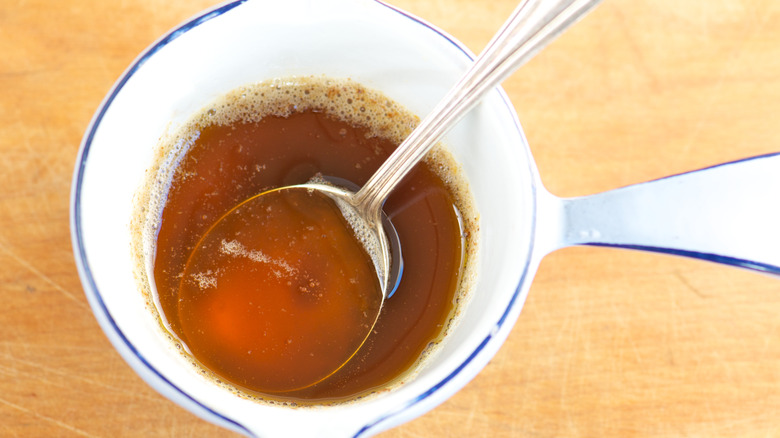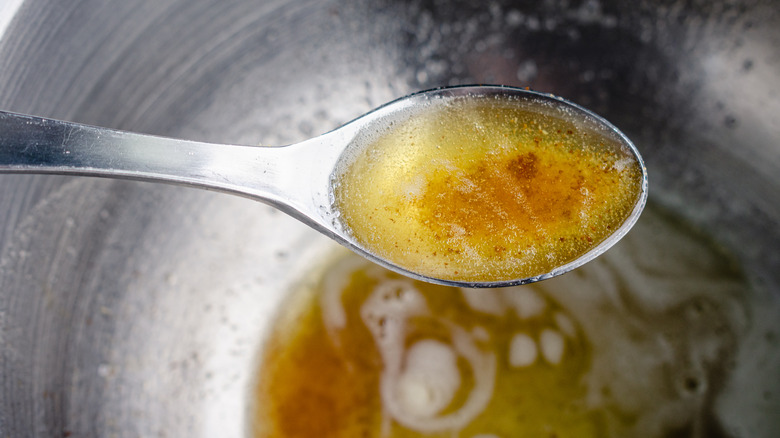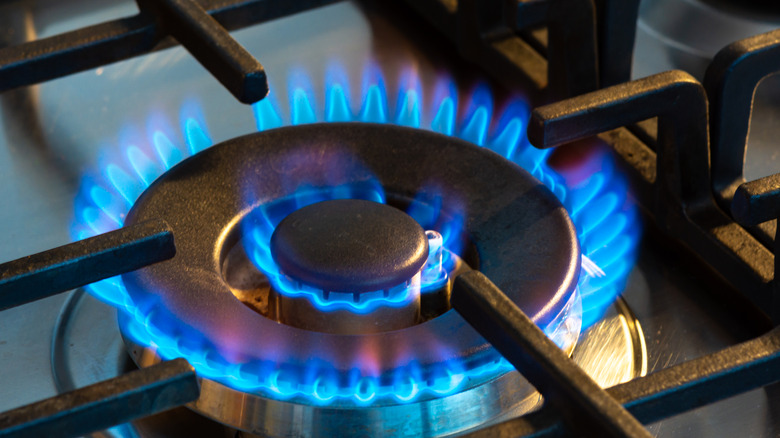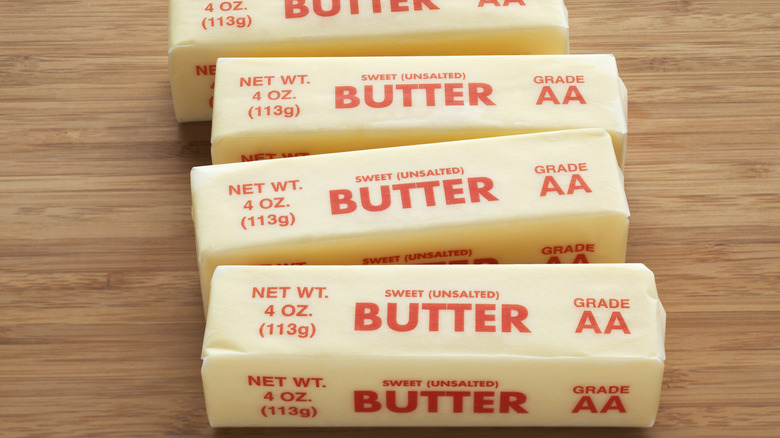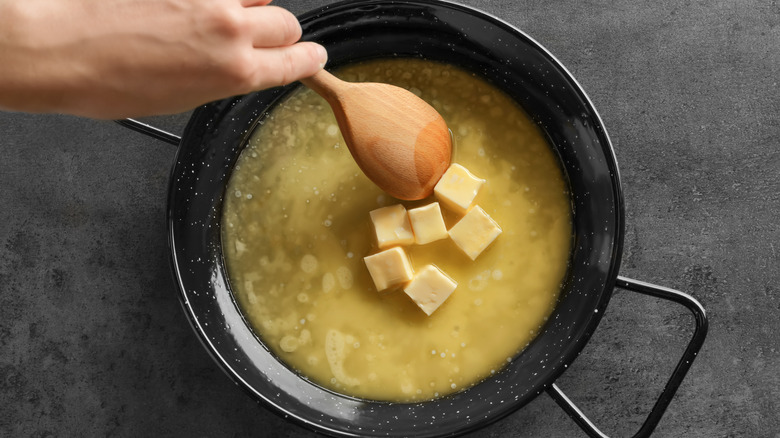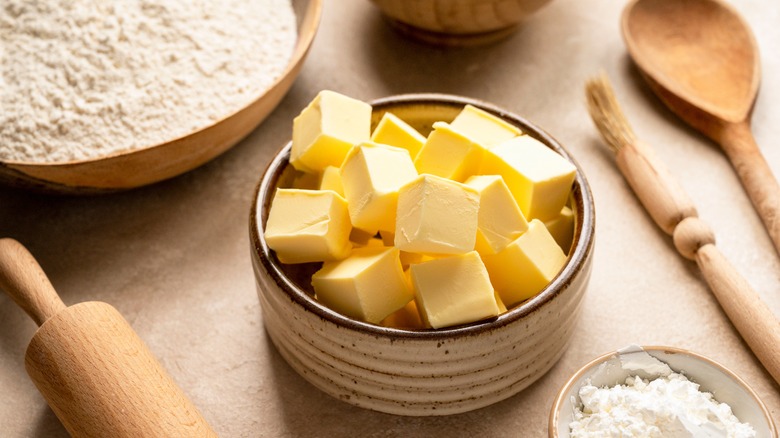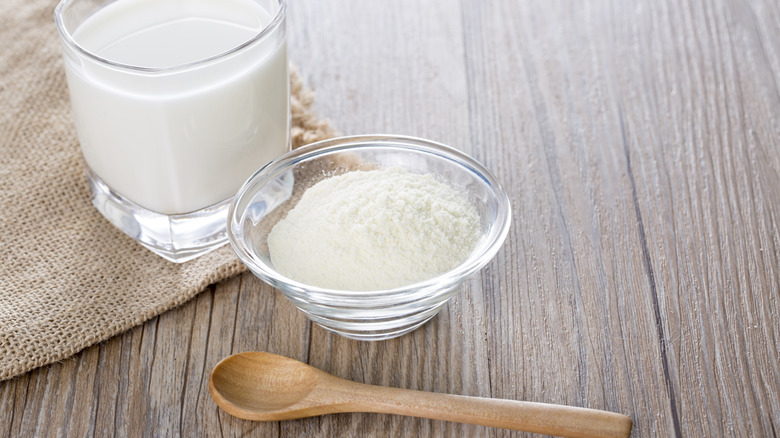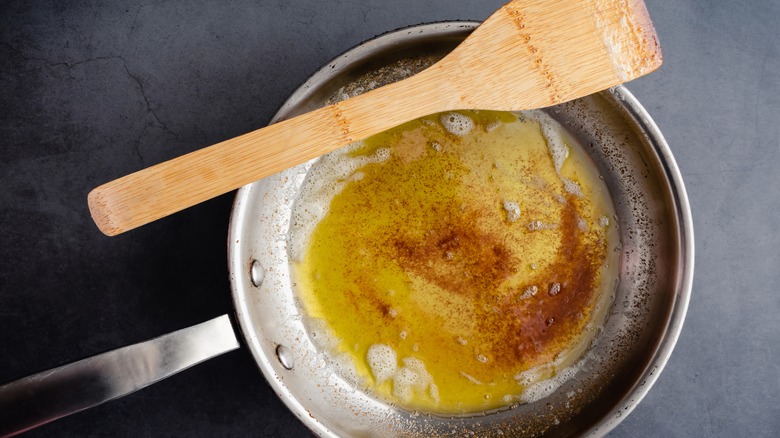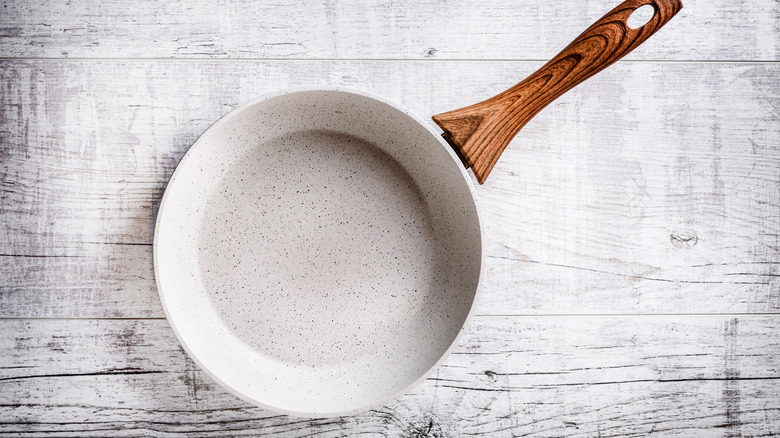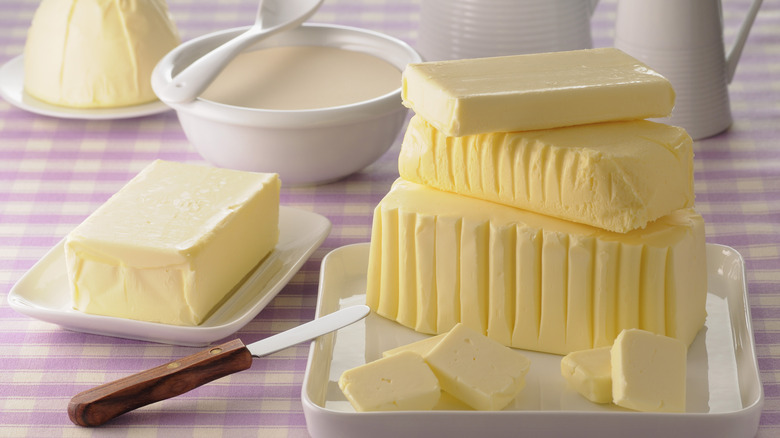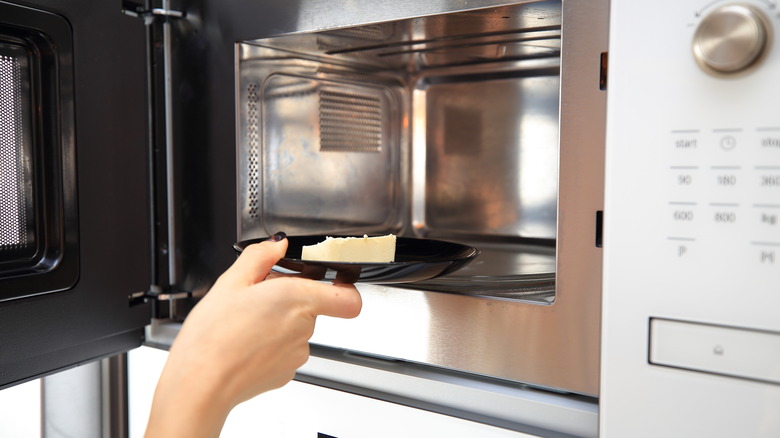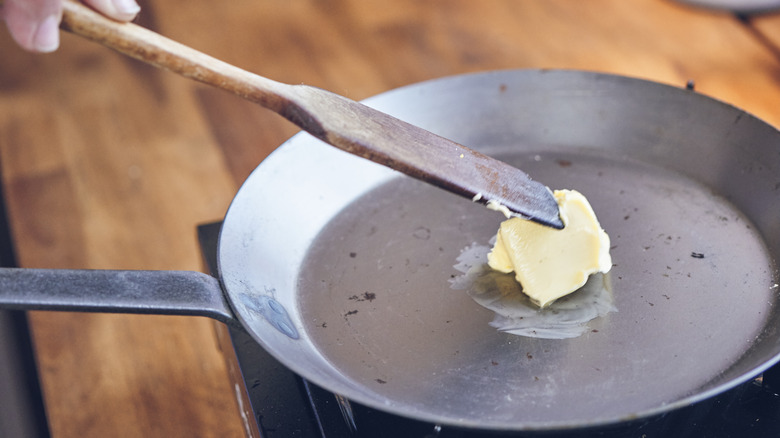Mistakes You're Making When Browning Butter
Brown butter is one of those special delicacies that simultaneously is extremely simple to make and adds so much to all sorts of dishes. For those who have never attempted it, brown butter ("beurre noisette" in French) is a simple sauce made by cooking butter until milk solids darken to a golden brown. Not simply melted butter, true brown butter has a nutty taste, smell, and even color — its French name translates to hazelnut butter — that can be used in everything from meat dishes to eggs to vegetables and sweet baked goods.
French-inspired cuisine can seem intimidating, but it certainly does not have to be. Learning to properly make and use brown butter can be an easy way to try something new, quickly elevating your cooking and baking to a new level with minimal effort and no need to buy pricy ingredients or new equipment.
Whether you've made brown butter before or not, the following guide can help ensure you do it right. Read on, and be sure to avoid the following mistakes that can occur when browning butter.
Overcooking it
Brown butter is not especially difficult to make, even for amateur chefs. However, timing is key. If you undercook brown butter, you won't achieve the rich, nutty taste you're going for; you'll essentially just add melted butter to your dish of the day.
At the same time, leaving the heat on for too long can pose problems. Remember, it's called brown butter, not blackened butter.
The trick is to know what to look for. As you melt the butter, you want to look for dark "flecks." When you see them, you'll know that the butter is toasting. Over time, you will see them start to darken; at the same time, you should also start to smell that signature nutty aroma. This is how you'll know it's done — and at this point, you will want to promptly remove the brown butter from the heat.
Just be careful not to wait too long, as you don't want the butter to start scorching.
Setting the heat too high
Overcooking brown butter is understandably a potential problem, but the risk can be compounded if you have the butter over too high heat. Whether you're using a gas stove, an electric stove, or even a portable induction burner, getting the right heat to make brown butter is key.
So what heat level do you want to use? As a rule of thumb, even, medium heat will allow for the most consistency when making brown butter.
As you cook, remember that all stoves are different — especially electric ones. Carefully monitor the heat to see that the butter is melting regularly and evenly. If it's rapidly starting to sizzle, that might be a sign that your heat is too high. And if it's taking forever to melt, that may be a sign that the heat is too low. After all, some degree of toasting is necessary to achieve the desired, nutty flavor.
Using salted butter
Technically, you can use either salted or unsalted butter to make brown butter. The only difference between the two is that salted butter has salt added to it. But, as with most baking projects, you are almost certainly better off using unsalted butter.
Why? Well, in some cases, salted butter will impart the exact amount of salt for whatever dish you're making, perfectly balancing the dish's saltiness.
But in most cases — and especially when making something simple yet subtle, like brown butter — that's a pretty big gamble. Ending up with too-salty brown butter is a bummer, and in some cases, may end up seriously undermining whatever cooked or baked dish you're working toward. If salted butter is all you have on hand, go ahead and brown it. But when you have a choice, stick with unsalted butter, and add any necessary salt at the end.
Not stirring enough as it cooks
The difference between brown butter and melted butter is pretty subtle. But it's also important, and that distinction is essential to correctly make brown butter. In other words, you can't just set a burner with some butter over medium heat, step away, and go about your business. You have to pay attention, and that includes properly stirring the brown butter as it cooks.
Is there a right way to stir? Stirring is stirring, isn't it? Not necessarily. Brown butter benefits from constant stirring as it cooks, which helps the butter avoid burning and ensures even melting throughout.
Plus, the tool you use can matter. Working constantly with a whisk will keep the butter moving — and not smoking. That constant attention you'll be giving it will also help, as you'll be immediately clued into something going wrong, like obvious burning, irregular melting, or overly high heat.
Remember, making brown butter may not be too complicated, but it is important to pay attention.
Not cutting butter uniformly
There's another key difference between simply melting butter — for a baked good, sauce, or something else — and making true brown butter. Cutting butter into pieces is best for brown butter. Even more important is size; when making brown butter, you want to cut your butter into uniform-sized pieces.
This may seem pretty obvious — or alternatively, unnecessary — but remember that subtlety is key when making brown butter. Navigating the timing between when that butter gets the nutty smell and look you're after and when it starts to scorch is an art. And so, unsurprisingly, having your butter melt at roughly the same rate can go a long way toward even cooking. If the butter is sized irregularly, a smaller piece might start to brown while a larger one is still melting.
If something goes wrong, though, don't panic. Using a utensil to speed up the melting of a larger piece can help even things out. So can lowering the heat and, by moving the pan, concentrating the flame or heat on the part that's melting more slowly.
Not including powdered milk
Traditionally, brown butter has only one ingredient: butter. But there is at least one way to spice it up. Adding powdered milk to brown butter can potentially take it to a whole different level, bringing out an even more premium version of the rich nuttiness that gives brown butter its signature flavor.
There's a simple explanation for why this works. Brown butter gets its flavor from what's known as the Maillard reaction — as water in the butter evaporates, milk solids and fat are left. Heating the sugar and amino acids in those milk solids produces the nutty flavor you're after.
Turns out powdered milk (if used properly) can actually boost that process. Powdered milk is composed of milk solids, so adding extra milk solids to butter as it browns can understandably impart extra nuttiness.
Just be careful not to add too much. More than a couple of tablespoons per stick of butter can cause the brown butter to clump up and produce a paste or powder. Start slow and see how it brings your beurre noisette to the next level.
Straining it
If you have not made brown butter before, on completion you may be tempted to strain it. This is probably because you'll notice some brown flecks floating in it, which may strike you as aesthetically unappealing at best, and unpalatable at worst. Some recipes may even suggest straining to end up with a "smoother" version of brown butter.
While the choice is ultimately up to you, straining brown butter can definitely impair the final flavor. Turns out, those little flecks are actually browned milk solids, and they are essential for brown butter's nutty flavor. Removing those little caramelized pieces won't remove all the flavor from your brown butter, but it will definitely remove some of it.
If a crystal clear sauce is of the utmost importance to you, you may want to strain it — and if you've overcooked your brown butter, straining it may help reduce a potentially bitter taste. But in most cases, serve it as it is.
Using a dark or scalded pan
You may not give a lot of thought to the pan you use when cooking or baking, or you may just be set in your routines. A small pan is a small pan, so why not use any typical cookware to make brown butter?
While you might be fine using any of your kitchen equipment, don't forget that identifying properly heated brown butter is heavily dependent on color. You want the butter to get that exact shade of brown, and while the smell is important in knowing when it's done, its visual appearance is also vital.
For this reason, it's good to avoid making brown butter in dark pans. This might include Teflon-coated pans, cast iron pans, and even pans with scald marks or staining. While things might initially seem unproblematic, those pan colors can make it a lot harder to identify when brown butter is done when the time comes. Play it safe and use a lighter-colored pan that really lets the brown color stand out.
Using butter with less fat
For a number of reasons, many chefs and bakers like to use low-fat butter. For the most part, it still tastes great, and (obviously) it has a lower fat content. When it comes to brown butter, though, it's important to opt for a higher-fat variety.
The Maillard reaction depends on sugar and fat in the butter to give the characteristic nutty flavor and "brown" appearance. Butter with a lower fat content won't undergo the reaction as effectively, leaving your final product less well-browned than it otherwise would be.
A good rule of thumb is to look for a European butter brand. European butter has at least 82% butterfat, whereas American brands have at least 80% butterfat. Of course, some American brands are labeled as "extra creamy" (or similar) and do have higher fat content. When in doubt, a European brand is usually a safe bet.
Not considering the microwave
Despite its fancy French name, brown butter is, at the end of the day, awfully simple to make. While it takes some practice to get it perfect, it's definitely an accessible recipe, especially when you consider how much it can add to a dish.
Turns out, there's another way to make it even more accessible: making it in the microwave. Though it might earn the disapproval of premier chefs, if you're short on time and do have a microwave, nuking it can more or less get the job done.
Doing it this way is pretty easy. Start by putting butter in the microwave in a bowl with a microwave-safe lid (or with a piece of parchment paper weighed down by a microwave-safe plate). Set the timer for 3 minutes, 30 seconds, and check it. Remember, you want it to get a dark, brownish color, to smell nutty, and above all, to not be burnt. If it's not done, microwave it for 30 seconds at a time until it's ready. Not quite as glamorous as on the stove-top, but it works.
Not knowing the sounds and smells to look for
Making brown butter may not be too hard, but as mentioned, it takes some skill, and there definitely is an art to doing it right. The better you get, the more confidently you'll be able to add brown butter to all sorts of cooked and baked dishes.
As you improve at making it, you will become more familiar with the sounds and smells to look for. So, let's review them.
First, there's the signature smell. The process of the Maillard reaction, and the proteins and sugars breaking down, is what ultimately produces brown butter. You're after a fragrant, nutty aroma — fairly prominent around the pan — which should be distinct from that of simple melted butter.
But the visual dimension may be even more key. As the water in the butter boils off, the butter will crackle and foam. Once that stops, the water should have mostly evaporated, and the butter should be brown. That's also a good signal that your brown butter is ready. You'll want to remove it from the heat quickly; otherwise, it might rapidly begin to burn.
